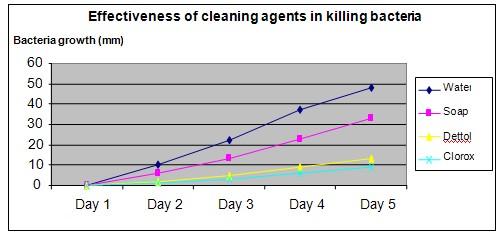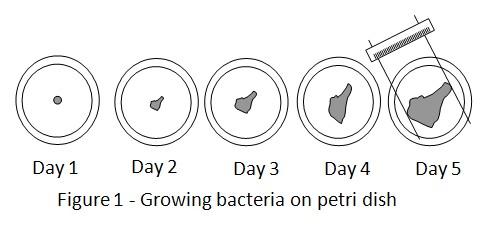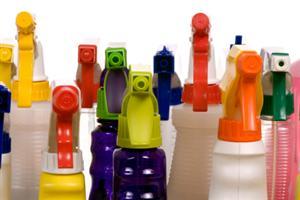| Complexity level: | 7 |
| Project cost ($): | 30 |
| Time required: | 1 day to prepare, 5 days for science fair project |
| Material availability: | Easily found |
| Safety concerns: | The bacteria should be destroyed before being disposed of. Pour some bleach into the petri dish to kill all the bacteria before disposing of the dishes in the trash. |
Hypothesis
Dettol solution is the most effective disinfectant, followed by Clorox.
Overview
Household cleaning agents
Bacteria are found all around us and cannot be completely eliminated from our homes. Our bodies have acquired immunity against most types of bacteria from the time we were born and therefore they are harmless to us. However there are still some bacteria around that can do us harm and that is why we have to ensure cleanliness and hygiene around us.
At grocery and department stores, so many types of soaps, detergents and disinfectants are sold. Some of these are used for personal hygiene purposes whereas others are used for floor cleaning, dishwashing or washing toilets. Some products are multipurpose cleaners that can be used to wash anything. It is best to leave the cleaning solution on the surface for a while, to allow it to become more effective in killing bacteria.
The presence of grease in the kitchen sink or other parts of the house attracts dust, mites and small insects. Grease is also the ideal place for bacteria to multiply and grow. Stronger cleaning agents are normally required to remove grease.
Scientific Terms
Materials
The materials required for this science fair project:
- 4 agar petri dishes prepared with blood agar
- 4 disinfected swabs
- 1 bottle of disinfected water
- 4 used plastic chopping boards
- tap water
- 1 bottle dishwashing soap
- 1 bottle of Dettol soap
- 1 bottle of Clorox
- 4 mackerel fish (or any other type of fish)
- 1 knife
- 1 marker pen
Procedure
1. For this science fair project, the independent variable is the type of cleaning agent used to wash the chopping board – water, dishwashing liquid, Dettol or Clorox. The dependent variable is the size of the bacteria colony in the petri dish. This is determined by measuring the size of the bacteria colony with a ruler. The constants (control variables) are the room temperature, the amount of sunlight and the ingredients in the petri dish agar.
2. The 4 petri dishes are prepared with the blood agar and stored in a refrigerator. The petri dishes are allowed to settle at room temperature before the start of the science experiment, by taking them out of the refrigerator. The petri dishes are labeled A, B, C and D.
3. The 4 plastic chopping boards are also labeled A, B, C and D. One fish is cut and de-boned on each of the chopping boards and left there for 30 minutes before the boards are washed.
4. The chopping boards are cleaned as follows (according to their number) :
1 – wash only with water
2 – wash with water and dishwashing liquid soap
3 – wash with water and Dettol solution
4 – wash with water and Clorox solution
5. The sterilized swab is first soaked with the sterilized water. The swabs are rubbed over the plastic chopping boards and rolled over the petri dishes according to the numbering. For example the swab used on chopping board 1 will be rolled over petri dish marked 1. Ensure that you roll the swab across the entire surface of the agar.
6. The cover is closed and the 4 petri dishes are kept in a cool shaded place for the bacteria to grow.
7. The diameter of the bacteria colony is measured daily for the next 5 days and recorded in the table below .



Results
The results showed that the chopping boards cleaned with Dettol solution and Clorox solution have the least amount of bacteria remaining on the surfaces.
|
Cleaning Agent |
Size of bacteria growth over 5 days (mm) |
||||
|
Day 1 |
Day 2 |
Day 3 |
Day 4 |
Day 5 |
|
|
Water |
0 |
10 |
22 |
37 |
48 |
|
Dishwasher |
0 |
6 |
13 |
23 |
33 |
|
Dettol |
0 |
2 |
5 |
9 |
13 |
|
Clorox |
0 |
1 |
3 |
6 |
9 |
The graph below represents the results of our science project experiment.

Conclusion
Our hypothesis that Dettol was the most effective disinfectant, was proven to be false. Clorox was the most effective disinfectant, followed by Dettol, and then the dish-washing soap.
There is rising concern that frequent use of antibiotics is causing bacteria to mutate and become more resistant. The same concern is being raised regarding overuse of antibacterial soaps and similar cleaning agents.
Also consider
Try to repeat the science fair project using other cleaning detergents like antibacterial soap, Listerine or Bleach.
References
How effective are alternative household cleaners? - http://www.uwex.edu/news/2001/3/how-effective-are-alternative-household-cleaners
Bacteria and household cleaners - http://www.articlegarden.com/article.php?id=24882&act=print

